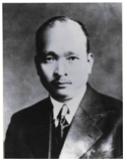Name: admin
2013-12-26 15:54:50 | Hit 2560
Files :  Kim Ki-jeong.docx
Kim Ki-jeong.docx
 Kim Ki-jeong.docx
Kim Ki-jeong.docx
Abductee: Kim Ki-Jeong
Recorded Date: April 3rd, 2008
Profile of Abductee
Name: Kim Ki-Jeong (male)
Date of Birth: February 18, 1896
Place of Birth: Cheongso-myeon, Boryeong-gun, Chungcheongnam-do, South Korea
Last Address: 40-9 Donam-dong, Seongbuk-gu, Seoul, South Korea
Date of Abduction: End of August or Beginning of September, 1950 (age 54)
Place of Abduction: Home
Occupation: Executive Director of the Korea Mining Association
Education/Career: Waseda University, Japan /County Governor of Chungcheongnam-do
Dependents: Wife, 3 Sons, 2 Daughters
Appearance/Personality: Big Eyes, Thin Hair, Good Character
Profile of Testifier
Name: Kim Jae-jo (born in 1941)
Relation: Second son
Type of Witness: Direct witness
Summary of the Abduction
- When the Korean War broke out, Kim Ki-jeong and his family believed ROK government’s
public announcement that was designed to make people feel safe in Seoul, therefore he and his
family missed the timing to evacuate Seoul.
- After resignation of the county governor in Chung-cheong Nam-do, the abductee was an executive
director of Korea Mining Association and was preparing for the 2nd parliamentary election of ROK.
- He was taken by an internal bureau officer, when he had returned home in order to check if his families were okay.
- He is presumed to be abducted because he was a useful high ranking official.
- Although 60 years have passed, his whereabouts has not been revealed due to the noncooperation of North Korea.
Detail of the Abduction
Q. Please tell us about what he did for living at the time of abduction.
When my father was studying in Waseda University in Japan before the Liberation, he and his friends joined the Independence Movement against the Japanese imperialism. Many of his friends began working in public offices after the establishment of the Republic of Korea and so did my father. He was a governor for different counties in Chungcheongnam-do, including Yesan and Seosan. He resigned from his position as a governor and moved to Seoul to run for the second National Assembly.
Q. Why didn’t he evacuate Seoul when the Korean War broke out?
While running for the election, he worked as an executive director for the Korea Mining Association, and that was when the Korean War broke out. My family was living in Donam-dong where we could see the Miari Ridge.
On the day when the Korean War broke out, my father was on a business trip to Seosan and only three people of my family including myself were at home. We thought about fleeing, but we only got as far as Euljiro 3-ga (now Se-woon Shopping Mall) where my older brother was living.
The ROK Army said the victory would be ours because the ROK soldiers already crossed the Miari Ridge and were moving forward to the North. However, four days after the outbreak of the Korean War, everything changed. It was too late to flee, so my family moved back to our house in Donam-dong.
Q. Please describe the abduction in detail.
My father, the abductee, was on a business trip, stayed where he was after the Korean War had broken out. There, he heard a rumor that all his family in Seoul died. Seriously worried, he returned home in disguise. It was very obvious that he was a target of the Internal Bureau since he had been in public office for a long time. Feeling a threat to his safety, he left the house for seven or ten days and then came home for a day or even shorter. It was the time he was abducted.
Around 5 a.m. in the next morning he returned home, there was a knock at the door. My father was about to have breakfast before leaving the house again after only sleeping for few hours. When I answered the Internal Bureau officer our neighbor who turned out to be working for the Internal Bureau was at the door with three officers from the Internal Bureau.
One of them pointed a gun at me and asked where my father was. My father barely touched his food but had to follow their order. He said, “I will be home soon because I did nothing wrong.” It happened in late August, about two months after the outbreak of the Korean War. That was the last time I ever saw my father again.
We had no idea that the neighbor was a leftist. He watched my father coming home the last night and informed on my father to the Internal Bureau. I later found out that he informed on approximately 50 rightist people in that way, to the Internal Bureau.
Q. Did they say anything to you when they took your father?
The Internal Bureau officer said that he would release my father after an interrogation so I thought he would be back soon. But he didn’t even after the day breaks. I went to the Internal Bureau to find him. At that time, there were two Internal Bureau Buildings near Donam-dong. One was a private residence of Dr. Jo Byeong-ok, located on the opposite side of the Miari Ridge and the other was in an area where now the Seong-buk Police Station is located. I did not know to which my father was taken, so I went to both of them and described what my father looked like.
The officers of both buildings said that they hadn’t seen anyone like my father, although they wouldn’t have told me even if they knew. I could not give up looking for him.
I was only 8 years old but went out to find anything about my father. In fact, I was the only one who could go out and look for my father with my mother because my older brother was involved in an activity of the Korea Young Men's Association (a rightist group) and had to hide from the Internal Bureau officers who were looking for rightists, and my younger sibling was just too young. My mother and I went out in search of him but could not hear any information about him.
Reason behind the Abduction
Q. Why do you think he was abducted?
As planned before the outbreak of the war, North Korea abducted the high-ranking government officials whom it had selected beforehand. I later found out from the list of abductees that a great number of people living in Donam-dong were taken to the North. It was because Donam-dong was a wealthy neighborhood where many high-ranking government officials lived.
My house was built only two years before the Korean War. It was a tile-roofed house and was well known as the house of the governor. I believe that my father was abducted because he had served in a high-ranking government post. They abducted as many high-ranking government officials as possible.
News after the Abduction
Q. Did you hear anything about him after he was taken?
Unfortunately nothing. At that time, there were a lot of small pine trees on the Miari Ridge. Along the trees was an air-raid shelter. When Seoul was about to be recaptured on September 28, the vicious North Korean Army made people line up in front of the ridge and shot them all dead.
I saw the North Korean Army continuously shooting innocent people. Dead bodies piled up over other bodies and eventually filled the entire air-raid shelter. After the North Korean Army retreated, my mother took me there to see if we can find the body of my father. The corpses were already decomposed due to the hot summer heat so we tried to find him by his clothes but failed. Even after the mass murder on the Miari Ridge, I witnessed the North Korean Army taking a great number of abductees to the North through Jeongneung-gil and the Arirang Ridge.
I also saw with my own eyes the North Korean Army hauling people by tying them with a string wire and shooting straggler mercilessly. Bodies were piled up in Jeongneung-gil and the Arirang Ridge as well. My mother and I went all the way to Jeongneung to find my father’s body, but once again, we failed. Even today, I hate to look at the Miari Ridge because that might be the place where my father was killed by the North Korean soldiers.
There was an elementary school named Jeongduk at the bottom of the Arirang Ridge and the North Korean Army used it as food storage. When the ROK Army was making their way toward Seoul, the North Korean Army set a fire on the storage. Everything was burnt, but people still went to the storage to pick even the burnt rice because there was virtually nothing to eat in town. The North Korean soldiers fired gunshots at them. Some of them were injured or even killed. The North Korean Army was brutal, vicious and merciless. Every single day was a continuation of chaos and disasters. It is way beyond the imagination of those who have no experience of it.
Recorded Date: April 3rd, 2008
Profile of Abductee
Name: Kim Ki-Jeong (male)
Date of Birth: February 18, 1896
Place of Birth: Cheongso-myeon, Boryeong-gun, Chungcheongnam-do, South Korea
Last Address: 40-9 Donam-dong, Seongbuk-gu, Seoul, South Korea
Date of Abduction: End of August or Beginning of September, 1950 (age 54)
Place of Abduction: Home
Occupation: Executive Director of the Korea Mining Association
Education/Career: Waseda University, Japan /County Governor of Chungcheongnam-do
Dependents: Wife, 3 Sons, 2 Daughters
Appearance/Personality: Big Eyes, Thin Hair, Good Character
Profile of Testifier
Name: Kim Jae-jo (born in 1941)
Relation: Second son
Type of Witness: Direct witness
Summary of the Abduction
- When the Korean War broke out, Kim Ki-jeong and his family believed ROK government’s
public announcement that was designed to make people feel safe in Seoul, therefore he and his
family missed the timing to evacuate Seoul.
- After resignation of the county governor in Chung-cheong Nam-do, the abductee was an executive
director of Korea Mining Association and was preparing for the 2nd parliamentary election of ROK.
- He was taken by an internal bureau officer, when he had returned home in order to check if his families were okay.
- He is presumed to be abducted because he was a useful high ranking official.
- Although 60 years have passed, his whereabouts has not been revealed due to the noncooperation of North Korea.
Detail of the Abduction
Q. Please tell us about what he did for living at the time of abduction.
When my father was studying in Waseda University in Japan before the Liberation, he and his friends joined the Independence Movement against the Japanese imperialism. Many of his friends began working in public offices after the establishment of the Republic of Korea and so did my father. He was a governor for different counties in Chungcheongnam-do, including Yesan and Seosan. He resigned from his position as a governor and moved to Seoul to run for the second National Assembly.
Q. Why didn’t he evacuate Seoul when the Korean War broke out?
While running for the election, he worked as an executive director for the Korea Mining Association, and that was when the Korean War broke out. My family was living in Donam-dong where we could see the Miari Ridge.
On the day when the Korean War broke out, my father was on a business trip to Seosan and only three people of my family including myself were at home. We thought about fleeing, but we only got as far as Euljiro 3-ga (now Se-woon Shopping Mall) where my older brother was living.
The ROK Army said the victory would be ours because the ROK soldiers already crossed the Miari Ridge and were moving forward to the North. However, four days after the outbreak of the Korean War, everything changed. It was too late to flee, so my family moved back to our house in Donam-dong.
Q. Please describe the abduction in detail.
My father, the abductee, was on a business trip, stayed where he was after the Korean War had broken out. There, he heard a rumor that all his family in Seoul died. Seriously worried, he returned home in disguise. It was very obvious that he was a target of the Internal Bureau since he had been in public office for a long time. Feeling a threat to his safety, he left the house for seven or ten days and then came home for a day or even shorter. It was the time he was abducted.
Around 5 a.m. in the next morning he returned home, there was a knock at the door. My father was about to have breakfast before leaving the house again after only sleeping for few hours. When I answered the Internal Bureau officer our neighbor who turned out to be working for the Internal Bureau was at the door with three officers from the Internal Bureau.
One of them pointed a gun at me and asked where my father was. My father barely touched his food but had to follow their order. He said, “I will be home soon because I did nothing wrong.” It happened in late August, about two months after the outbreak of the Korean War. That was the last time I ever saw my father again.
We had no idea that the neighbor was a leftist. He watched my father coming home the last night and informed on my father to the Internal Bureau. I later found out that he informed on approximately 50 rightist people in that way, to the Internal Bureau.
Q. Did they say anything to you when they took your father?
The Internal Bureau officer said that he would release my father after an interrogation so I thought he would be back soon. But he didn’t even after the day breaks. I went to the Internal Bureau to find him. At that time, there were two Internal Bureau Buildings near Donam-dong. One was a private residence of Dr. Jo Byeong-ok, located on the opposite side of the Miari Ridge and the other was in an area where now the Seong-buk Police Station is located. I did not know to which my father was taken, so I went to both of them and described what my father looked like.
The officers of both buildings said that they hadn’t seen anyone like my father, although they wouldn’t have told me even if they knew. I could not give up looking for him.
I was only 8 years old but went out to find anything about my father. In fact, I was the only one who could go out and look for my father with my mother because my older brother was involved in an activity of the Korea Young Men's Association (a rightist group) and had to hide from the Internal Bureau officers who were looking for rightists, and my younger sibling was just too young. My mother and I went out in search of him but could not hear any information about him.
Reason behind the Abduction
Q. Why do you think he was abducted?
As planned before the outbreak of the war, North Korea abducted the high-ranking government officials whom it had selected beforehand. I later found out from the list of abductees that a great number of people living in Donam-dong were taken to the North. It was because Donam-dong was a wealthy neighborhood where many high-ranking government officials lived.
My house was built only two years before the Korean War. It was a tile-roofed house and was well known as the house of the governor. I believe that my father was abducted because he had served in a high-ranking government post. They abducted as many high-ranking government officials as possible.
News after the Abduction
Q. Did you hear anything about him after he was taken?
Unfortunately nothing. At that time, there were a lot of small pine trees on the Miari Ridge. Along the trees was an air-raid shelter. When Seoul was about to be recaptured on September 28, the vicious North Korean Army made people line up in front of the ridge and shot them all dead.
I saw the North Korean Army continuously shooting innocent people. Dead bodies piled up over other bodies and eventually filled the entire air-raid shelter. After the North Korean Army retreated, my mother took me there to see if we can find the body of my father. The corpses were already decomposed due to the hot summer heat so we tried to find him by his clothes but failed. Even after the mass murder on the Miari Ridge, I witnessed the North Korean Army taking a great number of abductees to the North through Jeongneung-gil and the Arirang Ridge.
I also saw with my own eyes the North Korean Army hauling people by tying them with a string wire and shooting straggler mercilessly. Bodies were piled up in Jeongneung-gil and the Arirang Ridge as well. My mother and I went all the way to Jeongneung to find my father’s body, but once again, we failed. Even today, I hate to look at the Miari Ridge because that might be the place where my father was killed by the North Korean soldiers.
There was an elementary school named Jeongduk at the bottom of the Arirang Ridge and the North Korean Army used it as food storage. When the ROK Army was making their way toward Seoul, the North Korean Army set a fire on the storage. Everything was burnt, but people still went to the storage to pick even the burnt rice because there was virtually nothing to eat in town. The North Korean soldiers fired gunshots at them. Some of them were injured or even killed. The North Korean Army was brutal, vicious and merciless. Every single day was a continuation of chaos and disasters. It is way beyond the imagination of those who have no experience of it.
No |
Title |
Name |
Date |
Hit |
|---|---|---|---|---|
| 42 | Yun Tae-kyong |
admin |
13-12-26 | 2444 |
| 41 | Lee Ju-sin |
admin |
13-12-26 | 2040 |
| 40 | Son Hae-kyeong |
admin |
13-12-26 | 7055 |
| 39 | Seo Seung-kun |
admin |
13-12-26 | 2332 |
| 38 | Seo Byeong-ho |
adimn |
13-12-26 | 2549 |
| 37 | Park Sung-woo |
admin |
13-12-26 | 2091 |
| 36 | Park Hyon-Myong |
admin |
13-12-26 | 2280 |
| 35 | Lee Seong-hwan |
admin |
13-12-26 | 2525 |
| 34 | Lee In-hyeon |
admin |
13-12-26 | 2030 |
| 33 | Lee Hyung-ho |
admin |
13-12-26 | 17203 |
| 32 | Lee Gyu-chan |
admin |
13-12-26 | 5067 |
| 31 | Lee Gwang-soo |
admin |
13-12-26 | 2539 |
| 30 | Lee Gil-yong |
admin |
13-12-26 | 2231 |
| 29 | Lee Chae-deok |
admin |
13-12-26 | 16331 |
| 28 | Lee Bong-woo |
admin |
13-12-26 | 3367 |
| 27 | Kwon Tae-sul |
admin |
13-12-26 | 2623 |
| 26 | Kim Yu-yon |
admin |
13-12-26 | 2925 |
| 25 | Kim Ki-Jeong |
admin |
13-12-26 | 2559 |
| 24 | Kim Jae-bong |
admin |
13-12-26 | 2245 |
| 23 | Kim Gyeong-do |
admin |
13-12-26 | 2179 |






















 FAX : (82)31-930-6099
FAX : (82)31-930-6099
